Blockages are a common problem that any person living in an apartment or country house can face. As a rule, they arise suddenly, while there is not always the opportunity or time to call a specialist. In this case, you need to know how to clear the blockage in the bathroom at home.
It should be remembered that you should get rid of the problem even with the slightest stagnation of water. If you start this moment, it will take much more time and effort to eliminate the consequences. To understand what is the best way to clear the blockage in the bathroom, you need to know its size, location and composition.
The occurrence of blockages is caused by violations of the rules for using the sewage system. Pipes can become clogged due to the following factors:
- Incorrectly set slope angle of the sewer pipe during its installation.
- Debris and hair settling in the pipe.
- General deterioration of the sewer system.
- The appearance of fatty deposits.

Depending on the point of the sewer, the blockages will differ. So, in the case of a kitchen sink, the cause of blockages, as a rule, is food residues and oil, flowing along with water through the drain grate. Food settles in the siphon flask, and fat can accumulate on the pipes, especially intensively if their inner surface for some reason has lost its smooth surface.
The toilet becomes clogged due to the discharge of solid waste into it - vegetable peels, accidentally washed off rags. In apartment buildings, a blockage can occur on the general sewer drain due to the ingress of bulky debris into it. In this case, the malfunction cannot be eliminated on our own due to the lack of the necessary tools and a pipe inspection window in the apartment. The bathroom drain is clogged during the process of taking hygiene procedures. Knowing the methods of clearing blockages, you can deal with them on your own, without contacting the masters.
Dismantling the siphon

The main cause of traffic jams in the bathroom is the hair and hair of animals. At first, the garbage lingers on the drain grate, but if it is not removed in a timely manner, it, along with the water, will drain into the drain and get stuck in it. In addition, small objects such as earrings and rings can be dropped while showering. Initially, everything falls into a siphon, which performs two functions: it prevents odors from the sewer from entering the apartment and protects the pipes from debris.
If the water in the bathroom starts to drain poorly, and when you visually inspect the drain in the siphon, dirt and hair are visible, then you can disassemble this device to remove debris from it. This does not require special plumbing knowledge and equipment.
Before starting to dismantle the siphon, you should put a cloth that absorbs moisture well under it, and when disassembling the sink siphon, you can put a bucket or basin under it. This is to ensure that water flowing out during disassembly, often dirty, does not fall on the floor. The disassembly procedure will be as follows:
- The plastic nut is unscrewed, which is located near the drain on the inside.
- Disconnect the flask and drain the water from it.
- Next, the bottom of the siphon should be unscrewed and cleaned of debris, after which the flask is rinsed with water.
- The assembly is carried out in the reverse order, after which you need to supply water to identify possible leaks and check to remove the blockage.
Application of chemistry
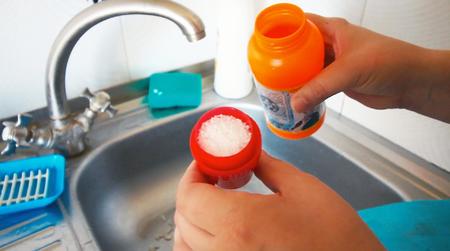
A variety of blockage chemicals are available. The components included in their composition can effectively destroy organic blockages, for example, fatty deposits. Such products are available both in the form of powders and in the form of liquids.
When using them, it is important to maintain the time indicated by the manufacturer. It is not recommended to overexpose funds, since not all materials of sewer pipes are resistant to aggressive chemical components.
It is enough just to pour liquid compositions into the drain hole and wait for the specified time. Powders are poured into the drain and filled with a small portion of water. At the end of the required time pause, the system is flushed with hot water.
The most common and reputable chemicals are:
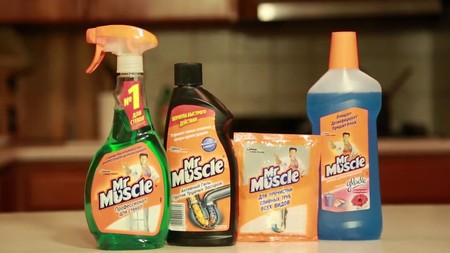
- Mister Muscle. In addition to floor cleaning products, the manufacturer produces products for removing blockages. It is a gel-like agent, in addition to punching blockages, it has antibacterial properties.
- Mole. Liquid concentrate of a mixture of hydroxon sodium and acetic acid. Available in gel form. Due to the presence of aggressive chemical components in the composition, its use is highly undesirable in pipes that are susceptible to the composition of the agent.
- Tiret. This agent is suitable for all materials of sewer pipes, as it does not contain aggressive chemicals.
- Flop. Powder remover for plaque and grease congestion.
In addition to specialized products, substances that can be found in almost every apartment do well with the elimination of organic blockages: acetic acid and soda ash. When they react with each other, they form a large amount of carbon dioxide, which pushes the congestion. In addition, acid additionally corrodes fatty deposits. In order to clear the blockage in the bath in this way, you need to do the following:
- Half a packet of soda is poured into the drain hole.
- After 15 minutes, half a glass of vinegar is poured and the drain is closed with a cork.
- Wait about an hour and a half, after which the plug is removed and 5-7 liters of hot water are poured.
The efficiency of the method with soda and vinegar decreases the more, the further from the drain the blockage is located. You can do without baking soda, pouring vinegar essence and adding small portions of hot water, but the result will be weaker.

Since almost all chemicals contain acids and alkalis, it is highly discouraged to work with them without personal protective equipment. To keep your hands safe, you should wear rubber gloves and goggles provide eye protection. In addition, you should carefully read the manufacturer's recommendations. Some pipes cannot withstand corrosive chemicals and begin to deteriorate. Irregularities created during this process will lead to the pipe losing the smooth surface of the walls, which guarantees the occurrence of new blockages in this place.
Mechanical methods
The chemicals do a good job with organic deposits, but are almost useless for blockages caused by accumulated debris. The simplest mechanical method is considered to be the use of a plunger. It consists of a cup-shaped or cone-shaped rubber attachment that is attached to a comfortable wood or plastic handle. Its principle of operation is based on crushing the dirt stuck in the sewer.
Clearing a blockage in the bathroom using a plunger is less effective than using it in the kitchen sink or toilet. This is due to the fact that a vacuum is needed to work with it. The bathroom drain is equipped with an additional overflow. If a blockage occurs, there will be air inside, which will reduce the effectiveness of the plunger.
However, it can help in the early stages of sewer clogging. The sequence of actions will be as follows:
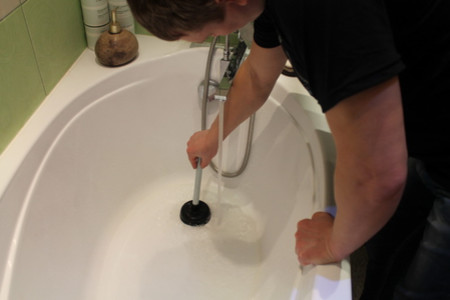
- The overflow opening of the bathroom is tightly closed. For this, a rubber stopper is used, which must be included in the set for the drain-overflow. If it is not there, you can get by with a cloth folded in several layers or close it with a second plunger.
- The plunger bowl is tightly pressed against the drain hole so that it completely covers it.
- Several (10-20) energetic reciprocating shocks take place. In this case, the nozzle should not move away from the walls of the bath.
- Then, with a sharp movement, the plunger is torn off the drain. Pour water and check the result.
- If the blockage persists, repeat the same steps, but with the addition of water. To do this, so much liquid is collected in the bath so that the rubber bowl of the plunger is almost completely covered. The plunger plunges to the hole, capturing water with its bowl, after which the actions are repeated.
To achieve the desired result, you can repeat the procedure several times, but if there are no improvements, then further work with the plunger will not bring results - the debris is too deep or has a strong structure.
Using a plumbing cable
The plunger helps with weak blockages, but the sewer can become so clogged that it will be useless, like chemicals. If a similar situation arises, you should know how to clear the blockage in the bathroom with a cable. It is presented in the form of a thick wire, on one end of which there is a brush or a hook, and on the other a handle for rotating.
With this brush, you need to pull the debris out or punch it to the wider part of the sewer pipe. Clearing the blockage is done as follows:
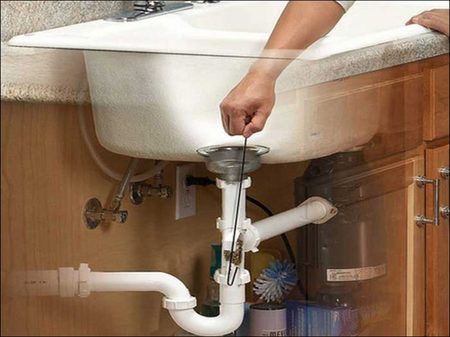
- The working tip fits into the drain hole.
- The cable is pushed along the pipe by rotating the handle.
- When the cable is brought to the blockage, several sharp jerks back and forth are made, gradually increasing the pressure.
- Remove the cable in reverse circular motions, removing debris.
- Hot water is supplied in order to flush the pipe with the removal of crushed deposits.
The plumbing cable allows you to get rid of blockages, which are caused even by solid debris, such as rags and cellophane films, entering the pipe. Its flexibility is enough to overcome all the irregularities and bends of the sewer pipe, even joints at 90 degrees. But to work with it, you need to be careful: too vigorous movements can damage the inner walls of the sewer pipe and drain hole. If desired, the cable can be made independently, having several meters of flexible steel rope available. It is enough to fluff its end, giving the shape of a petal.
Further prevention
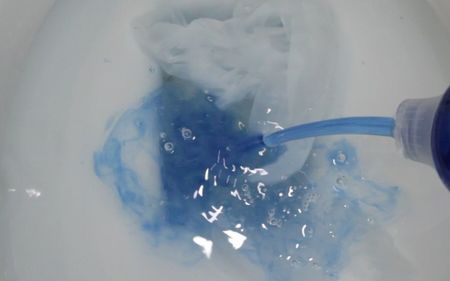
Understanding the blockage problem gives you an idea of why the bathtub is clogged and how to clean it. But it is better to avoid such troubles. Protective grilles help to protect the sewer pipes. Their main task is to prevent hair, animal hair and various debris from entering the sewer.
In addition, a small amount of hot water, preferably with salt, can be poured into the drain hole several times a month. She will melt fat deposits and flush them further down the drain.
For prevention, various chemical compounds help well. Most manufacturers of blockage removers have drugs that can be used to prevent this problem. They are distinguished by less aggressive components in the composition and, as a rule, can be used for pipes made of any materials. You also need to periodically disassemble the siphon in order to clean it and get rid of the resulting deposits. This is the most effective prophylaxis for the bath, during the operation of which the hair and hair of pets are constantly washed off.
